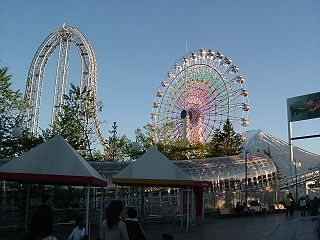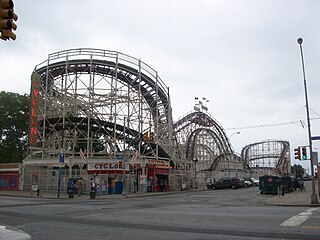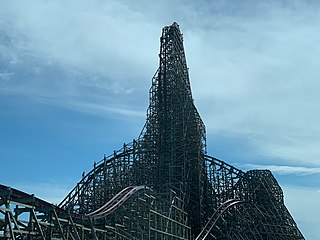
A roller coaster is a type of amusement ride employing a form of elevated railroad track that carries passengers on a train through tight turns, steep slopes, and other elements usually designed to produce a thrilling experience. Trains consist of open cars connected in a single line, and the rides are often found in theme parks around the world. Roller coasters first appeared in the 17th century, and LaMarcus Adna Thompson obtained one of the first known patents for a roller coaster design in 1885, based on the Switchback Railway which opened a year earlier at Coney Island.
A steel roller coaster is a type of roller coaster classified by its steel track, which consists of long steel tubes that are run in pairs, supported by larger steel columns or beams. Trains running along the track typically rely on wheels made of polyurethane or nylon to keep each train car anchored to the track. The introduction of tubular steel drastically changed roller coaster innovation, allowing for greater speeds, higher drops, and more intense elements such as inversions.

Top Thrill 2 is a launched roller coaster located at Cedar Point in Sandusky, Ohio, United States. The ride originally opened as Top Thrill Dragster in 2003, becoming the tallest and fastest roller coaster in the world, as well as the first ever strata coaster – a height classification of 400 feet (120 m) or more. Designed by Werner Stengel, the Accelerator Coaster model from Intamin debuted with a height of 420 feet (130 m) and could accelerate from 0 to 120 mph (190 km/h) in 3.8 seconds. It was themed to Top Fuel drag racing, with the launch track designed to resemble a dragstrip, and it consistently ranked as one of the world's top steel coasters in Amusement Today's annual Golden Ticket Awards publication. Top Thrill Dragster's records were surpassed in 2005 by Kingda Ka at Six Flags Great Adventure.

S&S – Sansei Technologies is an American company known for its pneumatically powered amusement rides and roller coaster designing.

The Big One, formerly known as the Pepsi Max Big One, is a steel roller coaster located at Pleasure Beach Resort in Blackpool, Lancashire, England. Designed by Ron Toomer and manufactured by Arrow Dynamics, the ride opened to the public on 28 May 1994 as the tallest and steepest roller coaster in the world, featuring a height of 213 feet (65 m) and a drop angle of 65 degrees. It held the title as the tallest until 1996 when Fujiyama opened in Japan. Construction of the ride cost £12 million. The ride was sponsored by Pepsi until 2011, at which time Pepsi Max was removed from the name.

Thunderbolt, previously known as Pippin, is a wooden roller coaster located at Kennywood amusement park in West Mifflin, Pennsylvania. It was originally built and designed by John A. Miller and opened in 1924. It was later renovated for the 1968 season, which involved a major track expansion designed by Andy Vettel. It reopened to the public as Thunderbolt. It is partially known for being one of the few rides at Kennywood to require a partner.

A hypercoaster is a roller coaster with a height or drop measuring at least 200 feet (61 m). The term was first coined by Arrow Dynamics and Cedar Point in 1989 with the opening of the world's first hypercoaster, Magnum XL-200, which features a height of 205 feet. The next hypercoaster, Pepsi Max Big One, opened five years later at Blackpool Pleasure Beach featuring a height of 213 feet (65 m).

Alpengeist is an inverted roller coaster located at Busch Gardens Williamsburg in Williamsburg, Virginia. Manufactured by Bolliger & Mabillard, Alpengeist has an Alpine mountain region theme and opened in 1997 as the tallest inverted coaster in the world. The name "Alpengeist" is German for "Ghost of the Alps" or "Alpine Spirit", and the ride is themed to a runaway ski lift. It has the records for the tallest complete circuit inverted coaster in the world, tallest inverted roller coaster in the United States, and the longest complete circuit coaster drop in the world.

Steel Force is a steel roller coaster located at Dorney Park & Wildwater Kingdom in Allentown, Pennsylvania. At 5,600 feet (1,700 m) in length, Steel Force is the eighth-longest steel coaster in the world as of 2024.

Fuji-Q Highland is an amusement park in Fujiyoshida, Yamanashi, Japan, owned and operated by the namesake Fuji Kyuko Co. It opened on 2 March 1968.

Do-Dodonpa (ド・ドドンパ), formerly known as Dodonpa (ドドンパ), was a steel roller coaster located at Fuji-Q Highland in Fujiyoshida, Yamanashi, Japan. Manufactured by S&S – Sansei Technologies, the launched coaster used compressed air to propel its trains. It opened on 21 December 2001 as the fastest roller coaster in the world with the fastest acceleration, reaching a top speed of 172 km/h (106.9 mph) in 1.8 seconds. The ride was refurbished in 2017, removing its top hat element in favor of a vertical loop, as well as increasing its speed and acceleration to 180 km/h (111.8 mph) in 1.56 seconds. In 2021, the ride was closed down indefinitely after multiple complaints of riders sustaining broken bones were raised. The ride's permanent closure was officially announced on 13 March 2024.

Phantom's Revenge is a steel hypercoaster located at Kennywood amusement park in West Mifflin, Pennsylvania. It originally opened as Steel Phantom in 1991, featuring the fastest speed and longest drop of any roller coaster in the world. Its second drop is longer than its first, which is a unique characteristic among roller coasters. Manufactured by Arrow Dynamics, the ride was later modified and renovated by D. H. Morgan Manufacturing for the 2001 season when it reopened as Phantom's Revenge. The drop and track length were both increased, and its four inversions were removed, allowing for the removal of its uncomfortable over-the-shoulder restraints.

Roller coaster amusement rides have origins back to ice slides constructed in 18th-century Russia. Early technology featured sleds or wheeled carts that were sent down hills of snow reinforced by wooden supports. The technology evolved in the 19th century to feature railroad track using wheeled cars that were securely locked to the track. Newer innovations emerged in the early 20th century with side friction and underfriction technologies to allow for greater speeds and sharper turns. By the mid-to-late 20th century, these elements intensified with the introduction of steel roller coaster designs and the ability to invert riders.

Moonsault Scramble (ムーンサルト・スクランブル) was a shuttle roller coaster located at Fuji-Q Highland in Fujiyoshida, Yamanashi, Japan. Manufactured by Sanoyas Hishino Meisho, the ride opened to the public on 24 June 1983. According to the Guinness Book of Records, Moonsault Scramble was the tallest roller coaster in the world at 70 metres (230 ft) when it opened. It held the record until the opening of Fujiyama, a coaster that opened at the same park in 1996, which reached 79 metres (259 ft) in height. The coaster was removed from the park in 2000 to make way for the construction of Dodonpa, which opened in 2001.

Centrifugal Railway was the name of a number of early looping roller coasters that were built in Western Europe in the middle of the 19th century. These rides were very similar in their basic design to many modern day shuttle roller coasters, but with only one lift hill and no launch. A single roller coaster car would ascend to the peak on the coaster before descending rapidly down the same hill and then passing through the central loop with enough speed to remain on the track at the top of the loop. The size of these centrifugal railways differed; some were purported to have vertical loops of a mere 6.5 feet (2.0 m), while others were estimated to be 40 feet (12 m).

Steel Curtain is a steel hypercoaster located at Kennywood amusement park in West Mifflin, Pennsylvania, United States. Manufactured by S&S – Sansei Technologies, the coaster reaches a height of 220 feet (67 m) and features eight inversions, including a 197-foot (60 m) corkscrew considered to be the world's tallest inversion. Themed to the Pittsburgh Steelers NFL football team, the roller coaster is named after the Steel Curtain, the nickname for the Steelers' defensive line during the 1970s.

The TMNT Shellraiser is a steel indoor roller coaster at Nickelodeon Universe amusement park, within the American Dream Meadowlands mall, in East Rutherford, New Jersey, United States. The roller coaster is a Euro-Fighter model manufactured by Gerstlauer, and themed to the 2012 Teenage Mutant Ninja Turtles television series. It is the steepest roller coaster in the world with a vertical drop of 121.5 degrees. The TMNT Shellraiser has the same layout as Takabisha at Fuji-Q Highland in Japan, a previous record holder for world's steepest roller coaster. The ride is temporarily closed due to track repairs. No opening date has been given.

A hybrid roller coaster is a category of roller coasters where the track is made out of one material, either steel or wood, and the support structure is made from another. Early hybrid coasters include mine train roller coasters from Arrow Development, which feature a steel track with a wooden support structure. Becoming increasingly more common are hybrids with wooden tracks and steel supports, such as The Voyage at Holiday World.



















